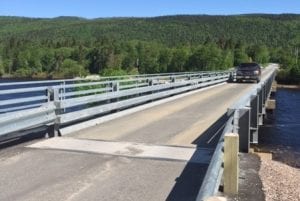July 2, 2015
Humber Village is a private residential community of about 60 homes near Corner Brook, NL, with its only connection to the Trans Canada Highway via a 423 m bridge. The steel beam structure over the Humber River had timber decking which was badly deteriorated. It was also dangerously narrow for pedestrian traffic. After many years of deliberation, the village corporation had their finances and plans in order and chose Brook Construction Ltd. to complete the refurbishing solution.

Algonquin Modular Panel Bridge components and steel decking have this multi-use bridge covered
Our Algonquin Modular Panel Bridge components and steel decking were used to create a new top on the existing steel beam super structure. This replacement system allowed traffic to still use the bridge at scheduled peak times and evenings during construction.
A wider and safer pedestrian crossing
The old bridge had a 3 m roadway and only a .7 m footway, with no adequate protection between pedestrians and vehicles. The components generated a 3.35 m roadway with a cantilevered and protected footway that is 1.5 m wide, thanks to the extended transoms.
This prefab bridge installation featured scheduled daily closures
The contractor’s crew gradually worked their way across the bridge, section by section, removing the old timber decking and installing the new galvanized epoxy-aggregate, anti-skid decking. Scheduled temporary re-openings occurred for peak travel times, evenings and weekends with vehicles crossing partly on the old deck and partly on the new deck.
The new “Bailey Bridge” approach panels met the existing steel girder bridge, making precision key
Since the ends of the original steel girder bridge were earlier extended by 3 m “Bailey” approach panels, the contractor had to place the first new transom at a precise location in order for the steel decking sections to work out properly at the other end. They also had to deal with the old bridge’s hand-drawn plans that were not always accurate. Plus, the old girders had variable flange thicknesses and gusset plate locations that needed to be made to fit with the new components.
Thanks to a very knowledgeable and hardworking local team, it all worked out well in the end — with a little help from our Algonquin Bridge on-site representative, of course.







